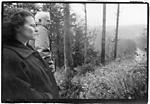“A HOUSE IS NOT a home/When there’s no one there/To hold you tight.” At least, that’s what Luther Vandross sang. Out in North Bend, the issue may come down to whether or not there’s a shower.
The question of what makes a house a home is proving to be a critical one in the fight over Grouse Ridge, a forested area that lies just off I-90. A Redmond company called Cadman is looking to extract $250 million worth of gravel from the mineral-rich ridge, which is presently owned by Weyerhaeuser. Unfortunately, the proposed excavation site is only steps away from the gated estate of Grand Master Sheng-Yen Lu, a world-renowned Buddhist leader from Taiwan who moved into these North Bend woods in the early ’90s.
The area has long been zoned “F”—for Forestry—which means that mining is OK. But an obscure footnote in King County code requires mining to take place at least a quarter-mile from any “established residence.” That means the fate of the mine could now rest on whether a certain mysterious building on the furthest edge of the Grand Master’s property is deemed by county bureaucrats to be “residential” or not.
If not, the Grand Master and other nearby homeowners could soon find their bucolic retreat shattered by the sight and sound of 1.5 million tons of rock being blasted, washed, crushed, sorted, and trucked away every year for the next 25 years.
The struggle over Master Lu’s property is only the latest surreal touch to a land-use battle that features all the off-key elements you would expect from Twin Peaks country. The controversy got under way last year, when an elaborate agreement was unveiled—involving everyone from Weyerhaeuser to Paul Allen to King County’s sewage sludge unit; everyone, that is, except North Bend residents—to transfer some 1,500 acres of I-90 forest land from Weyerhaeuser to the public. That land will be selectively logged for taxpayer benefit and also used as a place for the county to dump its “biosolids” (i.e., your waste). Three miles of riverside land donated by Paul Allen will be preserved as open space.
As part of the deal, a powerful conservation group called the Mountains-to-Sound Greenway agreed to throw its support behind Weyerhaeuser’s plans for mining Grouse Ridge—even agreeing to back up the company in court if it should get sued over the project. After 25 years of mining, Grouse Ridge, too, is supposed to be sold to the public—freshly landscaped, of course.
Not surprisingly, the plan has come in for some emotional opposition from the nearby residents of this formerly blue-collar town, which is now experiencing considerable spillover from all the Eastside wealth. Sitting in her spectacular custom-built log home overlooking the Middle Fork of the Snoqualmie River, Jacki Taylor, a visual artist and mother of two young children, says she worries about school buses sharing the road with 450 gravel trucks a day. The Snoqualmie Valley School District, which is planning a new elementary and middle school in Taylor’s neighborhood, has expressed reservations as well. (The actual stretch of shared road is only a couple blocks long and the neighborhood is already home to Ken’s Truck Town, a full-service truck plaza, where about 600 rigs pull in and out every day.)
Taylor says she met personally with Jim Ellis, the local civic legend who heads the Mountains-to-Sound Greenway, and pleaded with him not to support the mine. “I said, ‘I’m speaking as a desperate mother.’ My hands were like this. I was begging.” But Ellis told her he was committed to the Cadman plan, she says.
UP AGAINST A PHALANX of public and private forces, Taylor helped form an opposition group to the mine plan, called the Cascade Gateway Foundation, and recruited her next-door neighbor, Jeff Martine, to assist in the fight. Martine, the retired owner of a specialty print shop in Issaquah, is the wry realist to Taylor’s impassioned activism. “The world needs the gravel,” he observes, over lunch in Taylor’s living room. “The question is, how you do it to lessen the impact on people?”
Martine says the environmental studies of the project, which are scheduled to be released at the end of this month, are “just a big Kabuki deal. It’s not going to address our concerns.” The Foundation is hoping to convince Cadman to move its processing operation a few miles down the road to the next I-90 exit, where a mine is operating already. King County Executive Ron Sims has also asked the company to consider this option, which, for a number of reasons, is less desirable for Cadman.
The Foundation’s biggest hopes are pinned on the Buddhists. If county zoning experts determine that Grand Master Lu’s “established residence” is within a quarter-mile of the excavation site, then Cadman would be forced to seek a “conditional use permit” (or CUP). That would throw up some major barriers to the project, including much tighter environmental scrutiny and additional public hearings. “If we can force the CUP issue, we think Cadman will just say, ‘Screw it,'” says Jeff Martine.
Grand Master Lu has been slow to insert himself into the controversy. (His representatives declined comment.) This may be, in part, because the local limelight has not been especially kind to the Grand Master. His enormous Redmond temple, located in a suburban cul-de-sac near Lake Sammamish, has generated complaints from neighbors about noise and the thousands of visitors who gather there at holiday times. Lu also gained some notoriety when gubernatorial candidate Gary Locke visited his temple in 1996 and received an envelope from Lu containing $5,000 in cash. (An investigation into the affair by the state Public Disclosure Commission found no wrongdoing.)
But in the last two months, the Grand Master has roused himself. A few weeks ago, Lu’s lawyer sent a letter to King County contending that since Lu’s 10-acre estate lies within a quarter-mile of the proposed mining activities, “a CUP is required.”
Cadman, which claims to be the leading supplier of sand and gravel in Western Washington, has another idea. The company’s attorney, in his pitch to the county, argues that the quarter-mile is not meant to be measured from the property line but from the “dwelling unit” itself. The question then becomes: Which parts of Master Lu’s estate constitute his home?
One large structure built only last year on the edge of the property is at the center of the debate. Cadman’s attorney contends, based on the floor plan filed at the county, that this building is not a “residential structure” at all. It has “Two lavatories of institutional character consistent with religious assembly use,” the attorney writes in a letter; “These two lavatories provide no opportunity for showering or bathing.” Cadman even engaged a speaker of Taiwanese to translate the Chinese characters above the building’s main entryway, which, Cadman argues, suggest that the building is actually a temple.
Cadman also submitted the testimony of one of its geologists, who happened to be out at the site on a Sunday in early August and observed “approximately 80 people” walking out of the disputed structure, accompanied by monks in robes.
Attorneys for Lu and for Cascade Gateway contend that what the Grand Master does in the structure is irrelevant; the protections of the county code apply to his residence as a whole, not just the individual building in which he sleeps.
County bureaucrats are presently sorting through the arguments and should announce their decision in the next week or two. “There ain’t no black-and-white answers,” says a cheerful Gordon Thomson, who is overseeing the project for the county’s land use department. “That’s part of the intellectual challenge of this kind of job.”
Jeff Martine promises, “If there’s no CUP required, we’re going to litigate.”








